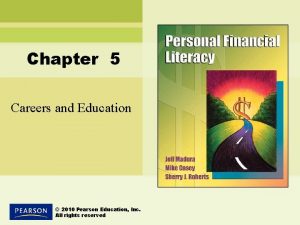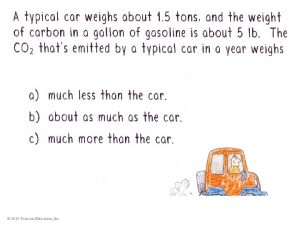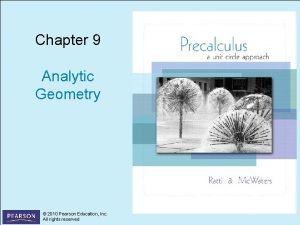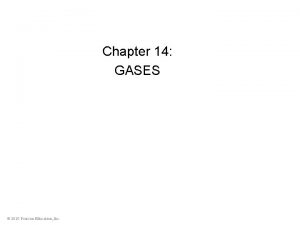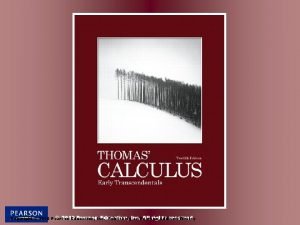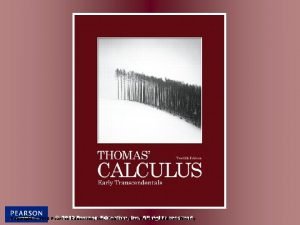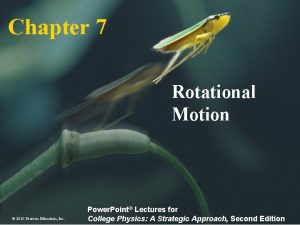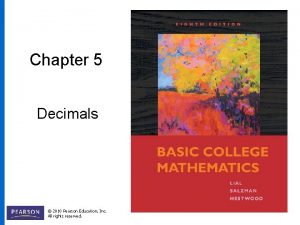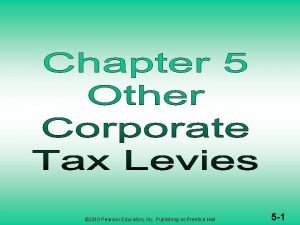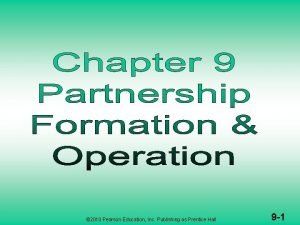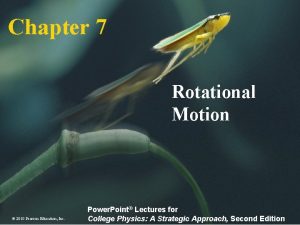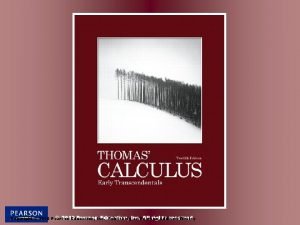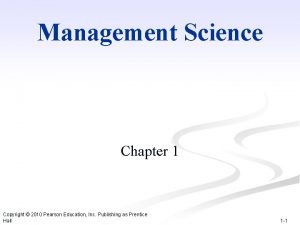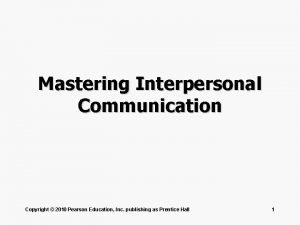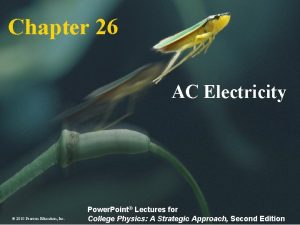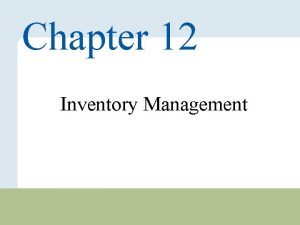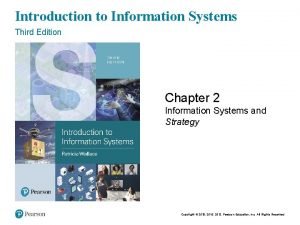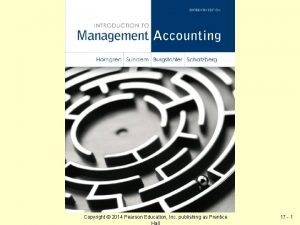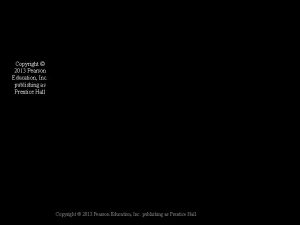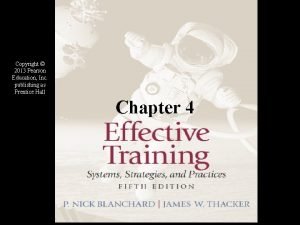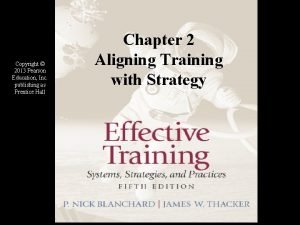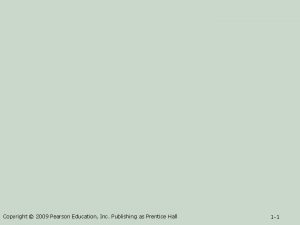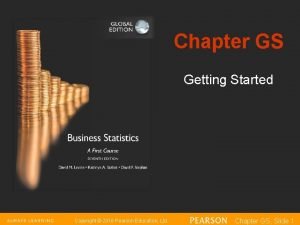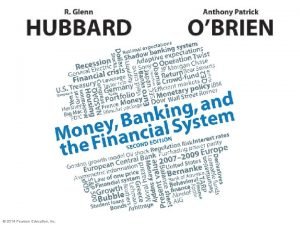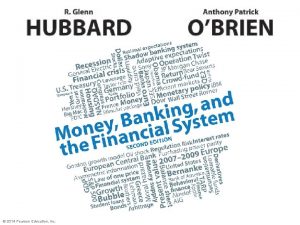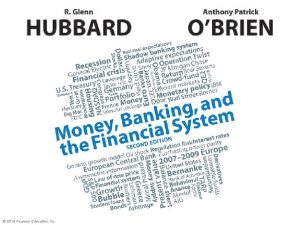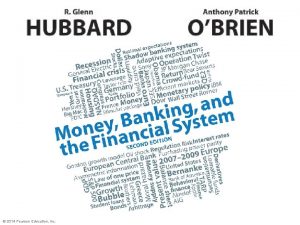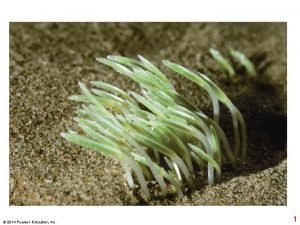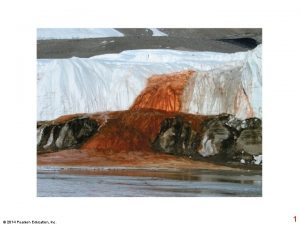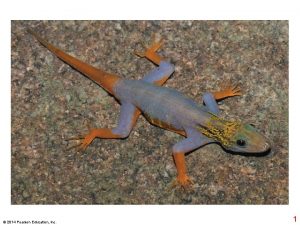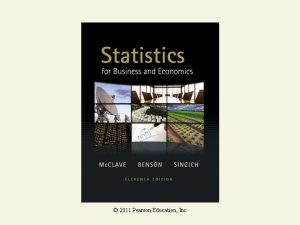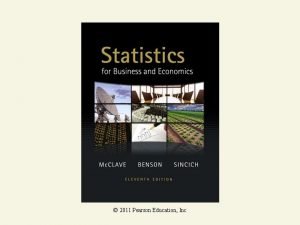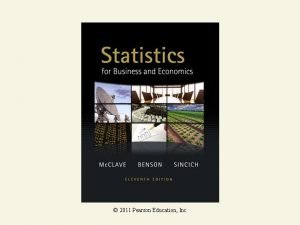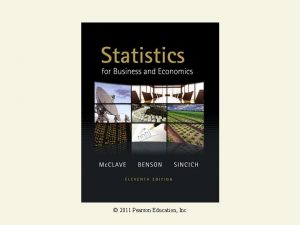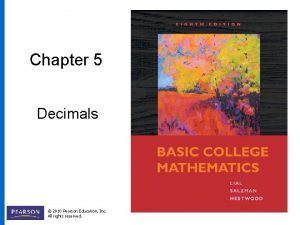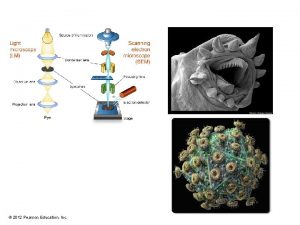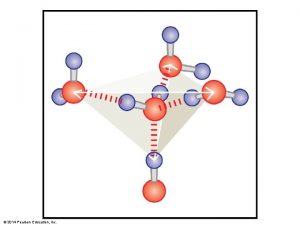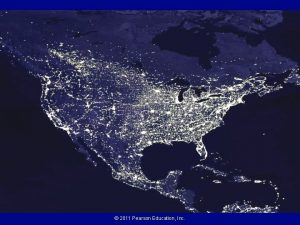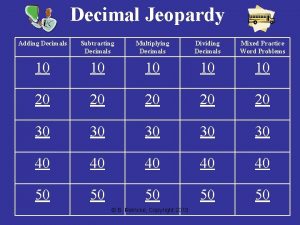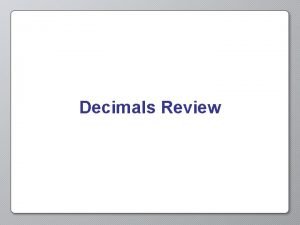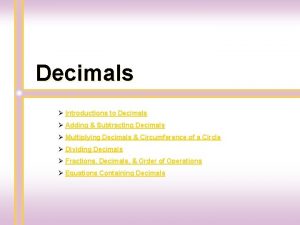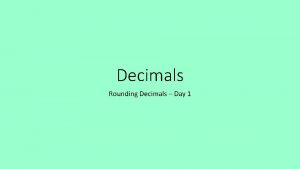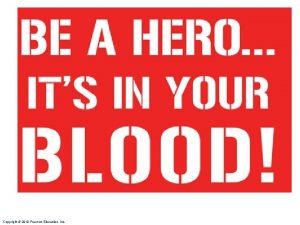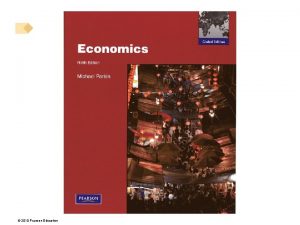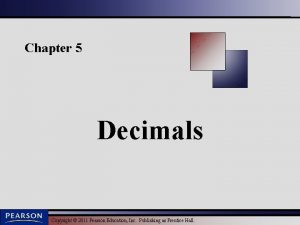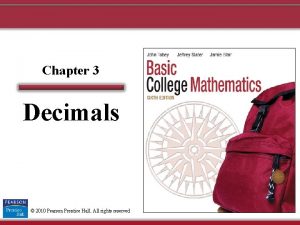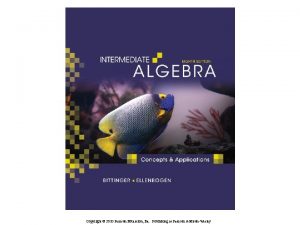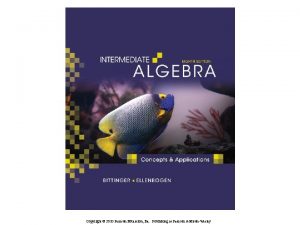Chapter 5 Decimals 2010 Pearson Education Inc All






































































- Slides: 70

Chapter 5 Decimals © 2010 Pearson Education, Inc. All rights reserved.

5. 1 Reading and Writing Decimals Objectives 1. Write parts of a whole using decimals. 2. Identify the place value of a digit. 3. Read and write decimals in words. 4. Write decimals as fractions or mixed numbers. Copyright © 2010 Pearson Education, Inc. All rights reserved. Slide 4. 1 - 2

Decimals are used when a whole is divided into 10 equivalent parts, or into 100 or 10, 000 equivalent parts. The dot in 0. 1 is called the decimal point. 0. 1 decimal point Copyright © 2010 Pearson Education, Inc. All rights reserved. Slide 4. 1 - 3

Parallel Example 1 Fraction Using the Decimal Forms of Fractions Decimal Read As a. 0. 6 six tenths b. 0. 11 eleven hundredths 0. 64 sixty-four hundredths 0. 352 three hundred fifty-two thousandths c. d. Copyright © 2010 Pearson Education, Inc. All rights reserved. Slide 4. 1 - 4

Copyright © 2010 Pearson Education, Inc. All rights reserved. Slide 4. 1 - 5

Parallel Example 2 Identify the Place Value of a Digit Identify the place value of each digit. a. 234. 89 4: ones tens 3: hundreds 2: tenths 8: hundredths 9: Copyright © 2010 Pearson Education, Inc. All rights reserved. Slide 4. 1 - 6

Parallel Example 2 Identify the Place Value of a Digit Identify the place value of each digit. b. 0. 12547 1: tenths 2: hundredths 5: thousandths 4: ten-thousandths 7: hundred-thousandths Copyright © 2010 Pearson Education, Inc. All rights reserved. Slide 4. 1 - 7

Parallel Example 3 Reading Decimal Numbers Tell how to read each decimal in words. a. 0. 4 four tenths b. 0. 52 fifty-two hundredths c. 0. 03 three hundredths d. 0. 826 eight hundred twenty-six thousandths Copyright © 2010 Pearson Education, Inc. All rights reserved. Slide 4. 1 - 8

Copyright © 2010 Pearson Education, Inc. All rights reserved. Slide 4. 1 - 9

Parallel Example 4 Reading Decimals Read each decimal. 7 is in the tenths place. a. 12. 7 twelve and seven tenths 12. 7 is read “twelve and seven tenths. ” Copyright © 2010 Pearson Education, Inc. All rights reserved. Slide 4. 1 - 10

Parallel Example 4 Reading Decimals Read each decimal. 1 is in the hundredth place. b. 352. 71 three hundred fifty-two and seven-one hundredths 352. 71 is read “three hundred fifty-two and seventy-one hundredths. ” Copyright © 2010 Pearson Education, Inc. All rights reserved. Slide 4. 1 - 11

Parallel Example 4 Reading Decimals Read each decimal. c. 0. 025 “twenty-five thousandths” d. 12. 2059 “twelve and two thousand fifty-nine tenthousandths” Copyright © 2010 Pearson Education, Inc. All rights reserved. Slide 4. 1 - 12

Copyright © 2010 Pearson Education, Inc. All rights reserved. Slide 4. 1 - 13

Parallel Example 5 Writing Decimals as Fractions or Mixed Numbers Write each decimal as a fraction or mixed number. a. 0. 21 The digits to the right of the decimal point, 21, are the numerator of the fraction. The denominator is 100 for hundredths because the rightmost digit is in the hundredths place. 100 for hundredths Hundredths place Copyright © 2010 Pearson Education, Inc. All rights reserved. Slide 4. 1 - 14

Parallel Example 5 continued Writing Decimals as Fractions or Mixed Numbers Write each decimal as a fraction or mixed number. b. 0. 743 1000 for thousandths Thousandths place The whole number part stays the same. c. 5. 0087 10, 000 for ten-thousandths Ten-thousandths place Copyright © 2010 Pearson Education, Inc. All rights reserved. Slide 4. 1 - 15

Parallel Example 6 Writing Decimals as Fractions or Mixed Numbers in Lowest Terms Write each decimal as a fraction or mixed number in lowest terms. a. 0. 4 10 for tenths b. 0. 45 Copyright © 2010 Pearson Education, Inc. All rights reserved. Slide 4. 1 - 16

Parallel Example 6 continued Writing Decimals as Fractions or Mixed Numbers in Lowest Terms Write each decimal as a fraction or mixed number in lowest terms. The whole number part stays the same. c. 22. 210 d. 54. 7075 Copyright © 2010 Pearson Education, Inc. All rights reserved. Slide 4. 1 - 17

5. 2 Rounding Decimals Objectives 1. Learn the rules for rounding decimals. 2. Round decimals to any given place. 3. Round money amounts to the nearest cent or nearest dollar. Copyright © 2010 Pearson Education, Inc. All rights reserved. Slide 4. 2 - 18

Copyright © 2010 Pearson Education, Inc. All rights reserved. Slide 4. 2 - 19

Parallel Example 1 Rounding a Decimal Number Round 16. 98467 to the nearest thousandth. Step 1 Draw a “cut off “ line after the thousandths place. 16. 984 67 Look only at the 6. Ignore the 7. Thousandths Step 2 Look only at the first digit you are cutting off. Ignore the other digits you are cutting off. Copyright © 2010 Pearson Education, Inc. All rights reserved. Slide 4. 2 - 20

Parallel Example 1 continued Rounding a Decimal Number Round 16. 98467 to the nearest thousandth. Step 3 If the first digit you are cutting off is 5 or more, round up the part of the number you are keeping. 16. 984 + 0. 0 0 1 16. 985 67 First digit cut is more than 5, so round up by adding 1 thousandth to the part you are keeping. So, 16. 98467 rounded to the nearest thousandth is 16. 985. We can write 16. 98467 ≈ 16. 985 Copyright © 2010 Pearson Education, Inc. All rights reserved. Slide 4. 2 - 21

Parallel Example 2 Rounding Decimals to Different Places Round 0. 8912 to the nearest hundredth. Step 1 0. 89 12 You are cutting off the 1 and 2. they will be dropped. Hundredths Look only at the 1. Step 2 Step 3 0. 89 12 The first digit is 4 or less, so the part you are keeping stays the same. 0. 8912 rounded to the nearest hundredth is 0. 89. We can write 0. 8912 ≈ 0. 89 Copyright © 2010 Pearson Education, Inc. All rights reserved. Slide 4. 2 - 22

In many everyday situations, such as shopping in a store, money amounts are rounded to the nearest cent. There are 100 cents in a dollar. Each cent is of a dollar. Another way of writing is 0. 01. So rounding to the nearest cent is the same as rounding to the nearest hundredth of a dollar. Copyright © 2010 Pearson Education, Inc. All rights reserved. Slide 4. 2 - 23

Parallel Example 3 Rounding to the Nearest Cent How much money will you pay in each shopping situation? Round each money amount to the nearest cent. a. $7. 6241 (Is it closer to $7. 62 or to $7. 63? ) $7. 62 First digit cut is 4 or less, so the part you are keeping stays the same. 41 You pay $7. 62. b. $3. 649 (Is it closer to $3. 64 or to $3. 65? ) $3. 64 First digit cut is 5 or more, so you round up. 9 $3. 64 + $0. 01 $3. 65 Copyright © 2010 Pearson Education, Inc. All rights reserved. You pay. Slide 4. 2 - 24

Parallel Example 4 Rounding to the Nearest Dollar Round to the nearest dollar. a. $84. 59 (Is it closer to $84 or to $85? ) First digit cut is 5 or more, so you round up. $84. 59 + 1 So $84. 59 rounded to the nearest dollar $85 is $85. b. $599. 79 (Is it closer to $599 or $600? ) So $599. 79 rounded to the + 1 First digit cut is 5 or nearest dollar is $600 more, so you round up. $600. Copyright © 2010 Pearson Education, Inc. All rights reserved. Slide 4. 2 - 25

5. 3 Adding and Subtracting Decimals Objectives 1. Add decimals. 2. Subtract decimals. 3. Estimate the answer when adding or subtracting decimals. Copyright © 2010 Pearson Education, Inc. All rights reserved. Slide 4. 3 - 26

Copyright © 2010 Pearson Education, Inc. All rights reserved. Slide 4. 3 - 27

Parallel Example 1 Adding Decimal Numbers Find each sum. a. 17. 23 + 56. 94 tenths hundredths tens ones Step 1 Write the numbers in columns with the decimal points lined up. 17. 23 +56. 94 Decimal points are lined up. Copyright © 2010 Pearson Education, Inc. All rights reserved. Slide 4. 3 - 28

Parallel Example 1 continued Adding Decimal Numbers Find each sum. a. 17. 23 + 56. 94 Step 2 Add as if these were whole numbers. 1 1 Step 3 17. 23 +56. 94 7 4. 1 7 Decimal point in answer is lined up under decimal points in problem. Copyright © 2010 Pearson Education, Inc. All rights reserved. Slide 4. 3 - 29

Parallel Example 1 continued Adding Decimal Numbers Find each sum. b. 3. 271 + 5. 819 + 16. 248 Write the numbers in columns with the decimal points lined up. 1 1 11 3. 271 5. 819 + 16. 248 2 5. 3 3 8 Decimal points are lined up. Copyright © 2010 Pearson Education, Inc. Publishing as Pearson Addison-Wesley Slide 4. 3 - 30

Parallel Example 2 Writing Zeros as Placeholders before Adding Find each sum. a. 6. 5 + 0. 72 There are two decimal places in 0. 72, so write a 0 in the hundredths place in 6. 5 so that it has two decimal places also. 6. 50 + 0. 72 7. 22 6. 50 is equivalent to 6. 5 in lowest terms is Copyright © 2010 Pearson Education, Inc. All rights reserved. Slide 4. 3 - 31

Parallel Example 2 continued Writing Zeros as Placeholders before Adding Find each sum. b. 9. 21 + 8 + 1. 378 Write in zeros so all the addends have three decimal places. 9. 210 8. 000 + 1. 378 18. 588 One 0 is written in. 8 is a whole number, decimal point and 3 zeros are written in. No zeros are needed. Decimal points are lined up. Copyright © 2010 Pearson Education, Inc. All rights reserved. Slide 4. 3 - 32

Parallel Example 3 Subtracting Decimal Numbers Find the difference. Check your answer. 13. 25 from 49. 68 Step 1 Step 2 Step 3 49. 68 − 13. 25 36. 43 Decimal points are lined up. Both numbers have two decimal places, no need to write in zeros. Decimal points are lined up. Check the answer by adding 36. 43 and 13. 25. If the subtraction is done correctly, the sum will be 49. 68. Copyright © 2010 Pearson Education, Inc. All rights reserved. Slide 4. 3 - 33

Parallel Example 4 Writing Zeros as Placeholders before Subtracting Find each difference. a. 21. 8 from 74. 341 Line up decimal points 74. 341 − 21. 800 52. 541 Check the answer by adding. Write two zeros Subtract as usual. 21. 800 + 52. 541 74. 341 Copyright © 2010 Pearson Education, Inc. All rights reserved. Matches minuend in original problem. Slide 4. 3 - 34

Parallel Example 4 continued Writing Zeros as Placeholders before Subtracting Find each difference. b. 28. 154 from 64. 900 − 28. 154 36. 746 Line up decimal points Write two zeros Subtract as usual. Copyright © 2010 Pearson Education, Inc. All rights reserved. Slide 4. 3 - 35

A common error in working decimal problems by hand is to misplace the decimal point in the answer. Or, when using a calculator, you may accidentally press the wrong key. Estimating the answer will help you avoid these mistakes. Copyright © 2010 Pearson Education, Inc. All rights reserved. Slide 4. 3 - 36

Parallel Example 5 Estimating Decimal Answers Use front end rounding to round each number. Then add or subtract the rounded numbers to get an estimated answer. Finally, find the exact answer. a. Find the sum of 283. 5 and 7. 913. Exact: Estimate: 283. 5 300 Rounds to + 7. 913 + 8 291. 413 308 The estimate goes out to the hundreds and so does the exact answer. Therefore, the decimal point is probably in the correct place. Copyright © 2010 Pearson Education, Inc. All rights reserved. Slide 4. 3 - 37

Parallel Example 5 continued Estimating Decimal Answers Use front end rounding to round each number. Then add or subtract the rounded numbers to get an estimated answer. Finally, find the exact answer. b. Find the difference between 0. 75 inches and 11 inches. Estimate: 11 − 1 10 Rounds to Exact: Write a decimal 11. 00 point and three zeros. − 0. 75 10. 25 inches Exact answer is close to estimate. Copyright © 2010 Pearson Education, Inc. All rights reserved. Slide 4. 3 - 38

5. 5 Multiplying Decimals Objectives 1. Multiply decimals. 2. Estimate the answer when multiplying decimals. Copyright © 2010 Pearson Education, Inc. All rights reserved. Slide 4. 4 - 39

Copyright © 2010 Pearson Education, Inc. All rights reserved. Slide 4. 4 - 40

Parallel Example 1 Multiplying Decimal Numbers Find the product of 5. 13 and 7. 4. Step 1 Multiply the numbers as if they were whole numbers. 5. 13 You do not have to line up the × 7. 4 decimal points when multiplying. 2052 3591 37962 Copyright © 2010 Pearson Education, Inc. All rights reserved. Slide 4. 4 - 41

Parallel Example 1 continued Multiplying Decimal Numbers Find the product of 5. 13 and 7. 4. Step 2 Count the total number of decimal places in both factors. 2 decimal places 5. 13 1 decimal places × 7. 4 3 total decimal places 2052 3591 37962 Copyright © 2010 Pearson Education, Inc. All rights reserved. Slide 4. 4 - 42

Parallel Example 1 continued Multiplying Decimal Numbers Find the product of 5. 13 and 7. 4. Step 3 Count over 3 places in the product and write the decimal point. Count from right to left. 2 decimal places 5. 13 1 decimal places × 7. 4 2052 3591 3 decimal places in 3 7. 9 6 2 product. Copyright © 2010 Pearson Education, Inc. All rights reserved. Slide 4. 4 - 43

Parallel Example 2 Multiplying Decimal Numbers Find the product (0. 056)(0. 09). Start by multiplying, then count decimal places. 0. 056 × 0. 09 504 3 decimal places 2 decimal places 5 decimal places needed in product Copyright © 2010 Pearson Education, Inc. All rights reserved. Slide 4. 4 - 44

Parallel Example 2 continued Multiplying Decimal Numbers 0. 056 × 0. 09. 0 0 5 0 4 3 decimal places 2 decimal places 5 decimal places needed in product After multiplying, the answer has only three decimal places, but five are needed, so write two zeros on the left side of the answer. Now count over 5 places and write the decimal point. The final product is 0. 00504, which has five decimal places. Copyright © 2010 Pearson Education, Inc. All rights reserved. Slide 4. 4 - 45

Parallel Example 3 Estimate before Multiplying First estimate the answer to (71. 47)(12. 8) using front end rounding. Then find the exact answer. Estimate: 70 × 10 700 3 decimal places are needed in the product. Exact: 71. 47 × 12. 8 57176 14294 7147 9 1 4. 8 1 6 Both the estimate and the exact answer go out to the hundreds place, so the decimal point in 914. 816 is probably in the correct place. Copyright © 2010 Pearson Education, Inc. All rights reserved. Slide 4. 4 - 46

5. 6 Dividing Decimals Objectives 1. Divide a decimal by a whole number. 2. Divide a number by a decimal. 3. Estimate the answer when dividing decimals. 4. Use the order of operations with decimals. Copyright © 2010 Pearson Education, Inc. All rights reserved. Slide 4. 5 - 47

There are two kinds of decimal division problems: those in which a decimal is divided by a whole number, and those in which a number is divided by a decimal. Recall the parts of a division problem. Copyright © 2010 Pearson Education, Inc. All rights reserved. Slide 4. 5 - 48

Parallel Example 1 Dividing Decimals by Whole Numbers Find each quotient. Check the quotients by multiplying. a. 18. 46 by 2 Dividend Divisor Rewrite the division problem. Step 1 Write the decimal point in the quotient directly above the decimal point in the dividend. . Copyright © 2010 Pearson Education, Inc. All rights reserved. Slide 4. 5 - 49

Parallel Example 1 continued Step 2 Dividing Decimals by Whole Numbers Divide as if the numbers were whole numbers. 9. 23 Matches, so 9. 23 is correct. Check by multiplying the quotient times the divisor. 9. 23 × 2 18. 46 Copyright © 2010 Pearson Education, Inc. All rights reserved. Slide 4. 5 - 50

Parallel Example 1 continued Dividing Decimals by Whole Numbers b. Dividend Divisor Write the decimal point in the quotient above the decimal point in the dividend. Then divide as if the numbers were whole numbers. 2 4. 6 14 32 28 42 42 0 Matches 24. 6 × 7 172. 2 Copyright © 2010 Pearson Education, Inc. All rights reserved. Slide 4. 5 - 51

Parallel Example 2 Writing Extra Zeros to Complete a Division Divide 7. 5 by 8. Check the quotient by multiplying. Keep dividing until the remainder is 0, or until the digits in the quotient begin to repeat in a pattern. 0. 9 375 72 30 24 60 56 40 40 0 0. 9375 × 8 7. 5000 Matches dividend, so 0. 9375 is correct. Stop dividing when the remainder is 0. Copyright © 2010 Pearson Education, Inc. All rights reserved. Slide 4. 5 - 52

Parallel Example 3 Rounding a Decimal Quotient Divide 5. 8 by 6. Round the quotient to the nearest thousandth. Write extra zeros in the dividend so you can continue dividing. 0. 9 666 54 40 36 4 Notice that the digit 6 in the answer is repeating. It will continue to do so. The remainder will never be 0. Remainder is still not 0. Copyright © 2010 Pearson Education, Inc. All rights reserved. Slide 4. 5 - 53

Parallel Example 3 continued Rounding a Decimal Quotient There are two ways to show that the answer is a repeating decimal. You can write three dots after the answer, or you can write a bar above the digits that repeat. 0. 9666… or When repeating decimals occur, round the quotient to the directions in the problem. In this problem, to round to the thousandths, divide out one more place, to the ten-thousandths. rounds to 0. 967 Check: (0. 967)(6) = 5. 802 Not exact because 0. 967 was rounded Copyright © 2010 Pearson Education, Inc. All rights reserved. Slide 4. 5 - 54

Copyright © 2010 Pearson Education, Inc. All rights reserved. Slide 4. 5 - 55

Parallel Example 4 Dividing by a Decimal Move the decimal point in the divisor three places to the right so 0. 004 becomes the whole number 4. Move the decimal point in the dividend the same number of places, write in an extra zero. 9210. Moving the decimal point three places to the right is like multiplying by 1000. Divide as usual. Copyright © 2010 Pearson Education, Inc. All rights reserved. Slide 4. 5 - 56

Estimating answers helps you catch errors. Compare the estimate to your exact answer. If they are very different, work the problem again. Copyright © 2010 Pearson Education, Inc. All rights reserved. Slide 4. 5 - 57

Copyright © 2010 Pearson Education, Inc. All rights reserved. Slide 4. 5 - 58

Parallel Example 6 Using Order of Operations Use order of operations to simplify each expression. a. 3. 9 + 5. 42 + 8. 16 Apply the exponent (5. 4) is 29. 16. 3. 9 + 29. 16 + 8. 16 Add from left to right. 33. 06 + 8. 16 41. 22 b. 8. 64 + (4. 8 – 3. 1)(2. 7) Work inside the parenthesis. 8. 64 + (1. 7) (2. 7) 8. 64 + 4. 59 Multiply next. Add last. 13. 23 Copyright © 2010 Pearson Education, Inc. All rights reserved. Slide 4. 5 - 59

5. 8 Writing Fractions as Decimals Objectives 1. Write fractions as equivalent decimals. 2. Compare the size of fractions and decimals. Copyright © 2010 Pearson Education, Inc. All rights reserved. Slide 4. 6 - 60

Copyright © 2010 Pearson Education, Inc. All rights reserved. Slide 4. 6 - 61

Parallel Example 1 Writing Fractions or Mixed Numbers as Decimals a. Write 3/8 as a decimal. 3/8 means 3 ÷ 8. Write it as The decimal point in the dividend is on the right side of 3. Write extra zeros in the dividend so you can continue dividing until the remainder is 0. Copyright © 2010 Pearson Education, Inc. All rights reserved. Slide 4. 6 - 62

Parallel Example 1 Writing Fractions or Mixed Numbers as Decimals b. Write as a decimal. One method is to divide 1 by 4 to get 0. 25 for the fraction part. Then add the whole number part. A second method is to write the mixed number as an improper fraction and then divide numerator by denominator. Copyright © 2010 Pearson Education, Inc. All rights reserved. Slide 4. 6 - 63

Parallel Example 2 Writing a Fraction as a Decimal with Rounding Write as a decimal and round to the nearest thousandth. Written as a repeating decimal, Rounded to the nearest thousandth, Copyright © 2010 Pearson Education, Inc. All rights reserved. Slide 4. 6 - 64

You can use a number line to compare fractions and decimals. The number line below shows the space between 0 and 1. The locations of commonly used fractions are marked, along with their decimal equivalents. Copyright © 2010 Pearson Education, Inc. All rights reserved. Slide 4. 6 - 65

This number line shows the locations of some commonly used fractions between 0 and 1 that are equivalent to repeating decimals. The decimal equivalents use a bar above repeating digits. Copyright © 2010 Pearson Education, Inc. All rights reserved. Slide 4. 6 - 66

Parallel Example 3 Using a Number Line to Compare Numbers Use the number lines to decide whether to write >, < or = in the blank between each pair of numbers. a. 0. 375 ____ 0. 3125 0. 375 is to the right of 0. 3125, use the > symbol. 0. 375 is greater than 0. 3125 > 0. 3125 0. 375 ____ Copyright © 2010 Pearson Education, Inc. All rights reserved. Slide 4. 6 - 67

Parallel Example 3 Using a Number Line to Compare Numbers Use the number lines to decide whether to write >, < or = in the blank between each pair of numbers. b. They are the same point on the number line. They are equivalent. = c. 0. 16 is less than < Copyright © 2010 Pearson Education, Inc. All rights reserved. Slide 4. 6 - 68

Parallel Example 4 Arranging Numbers in Order Write each group of numbers in order, from least to greatest. 0. 52 0. 513 0. 5204 It is easiest to compare decimals if they are all tenths, or all hundredths and so on. Because 0. 5204 has four decimal places, write zeros to the right of the other numbers so they also have four decimal places. Copyright © 2010 Pearson Education, Inc. All rights reserved. Slide 4. 6 - 69

Parallel Example 4 0. 52 Arranging Numbers in Order 0. 513 0. 5204 0. 52 = 0. 5200 = 5200 ten-thousandths 0. 513 = 0. 5130 = 5130 ten-thousandths 0. 5204 = 5204 ten-thousandths From least to greatest, the correct order is shown. 0. 513 0. 5204 Copyright © 2010 Pearson Education, Inc. All rights reserved. Slide 4. 6 - 70
 2010 pearson education inc
2010 pearson education inc Copyright 2010 pearson education inc
Copyright 2010 pearson education inc 2010 pearson education inc
2010 pearson education inc 2010 pearson education inc answers
2010 pearson education inc answers 2010 pearson education inc answers
2010 pearson education inc answers 2010 pearson education inc answers
2010 pearson education inc answers 2010 pearson education inc
2010 pearson education inc 2010 pearson education inc
2010 pearson education inc Copyright 2010 pearson education inc
Copyright 2010 pearson education inc 2010 pearson education inc
2010 pearson education inc Copyright 2010 pearson education inc
Copyright 2010 pearson education inc 2010 pearson education inc answers
2010 pearson education inc answers Pearson education inc 5
Pearson education inc 5 2010 pearson education inc
2010 pearson education inc Pearson education 2010
Pearson education 2010 Pearson education inc. all rights reserved
Pearson education inc. all rights reserved Two coins rotate on a turntable
Two coins rotate on a turntable 2010 pearson education inc
2010 pearson education inc 2010 pearson education inc
2010 pearson education inc 2010 pearson education inc answers
2010 pearson education inc answers 2010 pearson education inc answers
2010 pearson education inc answers 2010 pearson education inc
2010 pearson education inc Copyright 2010 pearson education inc
Copyright 2010 pearson education inc Copyright 2010 pearson education inc
Copyright 2010 pearson education inc Copyright 2010 pearson education inc
Copyright 2010 pearson education inc Copyright 2010 pearson education inc
Copyright 2010 pearson education inc Copyright 2010 pearson education inc
Copyright 2010 pearson education inc Composition copyright example
Composition copyright example Copyright 2010 pearson education inc
Copyright 2010 pearson education inc Pearson education inc. all rights reserved
Pearson education inc. all rights reserved 2010 pearson education inc answers
2010 pearson education inc answers Pearson income statement
Pearson income statement 2010 pearson education inc answers
2010 pearson education inc answers Pearson education inc. publishing as prentice hall
Pearson education inc. publishing as prentice hall Pearson education 2011
Pearson education 2011 Pearson education 2011
Pearson education 2011 Pearson education inc publishing as pearson prentice hall
Pearson education inc publishing as pearson prentice hall 2012 pearson education inc
2012 pearson education inc 2008 pearson prentice hall inc
2008 pearson prentice hall inc 2012 pearson education inc
2012 pearson education inc Pearson education inc. all rights reserved
Pearson education inc. all rights reserved Copyright pearson education inc
Copyright pearson education inc Pearson education ltd
Pearson education ltd Copyright by pearson education inc. answers
Copyright by pearson education inc. answers 2017 pearson education inc
2017 pearson education inc 2017 pearson education inc
2017 pearson education inc 2017 pearson education inc
2017 pearson education inc 2017 pearson education inc
2017 pearson education inc Pearson education inc 4
Pearson education inc 4 Pearson education, inc.
Pearson education, inc. 2014 pearson education inc
2014 pearson education inc 2013 pearson education inc
2013 pearson education inc 2013 pearson education inc
2013 pearson education inc Performance gap
Performance gap 2013 pearson education inc
2013 pearson education inc Pearson education inc. publishing as prentice hall
Pearson education inc. publishing as prentice hall 2012 pearson education inc
2012 pearson education inc Pearson education 2012
Pearson education 2012 2009 pearson education inc
2009 pearson education inc 2016 pearson education inc
2016 pearson education inc 2014 pearson education inc
2014 pearson education inc 2014 pearson education inc
2014 pearson education inc 2014 pearson education inc
2014 pearson education inc 2014 pearson education inc
2014 pearson education inc 2014 pearson education inc
2014 pearson education inc Water cycle pearson education
Water cycle pearson education 2014 pearson education inc
2014 pearson education inc 2011 pearson education inc
2011 pearson education inc 2011 pearson education inc
2011 pearson education inc 2011 pearson education inc
2011 pearson education inc Friedman rank test
Friedman rank test


